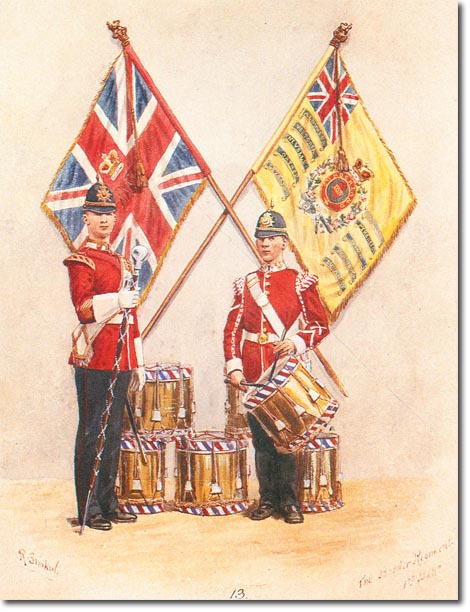|
|

 |
|
The artist Richard Simkin painted this c1890 to show men of the Border Regiment with the Colours of the 34th and the drums captured at Arroyo dos Molinos. On the right is a drummer and on the left is the Sergeant Drummer (down-graded from Drum-Major in 1881). Both this painting and the accompanying photo come from Simkin's Soldiers - The British Army in 1890 (vol II) by Col P S Walton (Picton Publishing 1986). Col Walton has this to say about the Colours:
The 1st Bn Colours have been represented quite accurately by Simkin. They were presented to the 34th Foot at Shorncliffe (Kent) by Lady Airey (wife of Sir Richard Airey) on 2nd August 1871. Infantry Colours had been steadily reduced in size from 6ft 6ins by 6ft 2ins of the mid Eighteenth Century and these were 3ft 9ins by 3ft (on the pike) exclusive of the fringe which was about 2ins deep. This size had been laid down in 1868 and is still valid today. The pike, however, was then 9ft 10ins tall (including the gilt Royal Crest at the head), by comparison with the modern 8ft 7.5ins. Infantry battalions have carried two Colours for more than 200 years and they are known as the Queen's Colour, which for line infantry is basically the Union flag, and the Regimental Colour. The Queen's Colour was embellished, in 1871, with the number of the regiment embroidered in Roman numerals with the crown above, all in gold (and colours). The Regimental Colour of the 34th was of yellow silk (their facing colour) with a small union in the upper canton. In the centre was the Union Wreath of Roses, Thistles and Shamrocks surmounted by a crown. Within that, on a scarlet ground, was a gold-edged circlet bearing the territorial title CUMBERLAND,itself surrounding the Regimental number in gold Roman numerals - as on the Queen's Colour but smaller. At this point Simkin seems to have made a mistake as he has shown the Wreath (an ancient badge) around the number. This was in accordance with the regulations but not with fact (see Photo) for the wreath was actually embroidered (in green) at the bottom of the Colour below the central device. The artist was however, entirely correct in his arrangement of the ten battle honours to which the 34th were entitled. |
Regimental Colours | Regimental details
Armed Forces | Art and Culture | Articles | Biographies | Colonies | Discussion | Glossary | Home | Library | Links | Map Room | Sources and Media | Science and Technology | Search | Student Zone | Timelines | TV & Film | Wargames